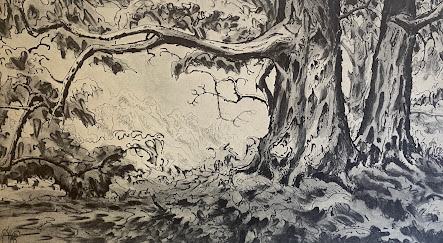CHARLES E. BURCHFIELD
Tuesday, June 18, 2024
THE THREE TREES
Tuesday, June 4, 2024
FRAGONARD'S DRAWINGS OF TREES
JEAN HONORÉ FRAGONARD
Foliage Study: Branches of a Chestnut Tree 1765
In October of 2016 we saw a show of Fragonard's landscape drawings at The Metropolitan Museum of Art in New York City. I took many photos of his drawings of trees. He was such a master of observational drawing. About this drawing of a Chestnut: "This sheet records the branches of a Chestnut Tree heavy with leaves and nuts. The study was likely inspired by the instruction of Charles Joseph Natoire, director of the Académie de France in Rome, who emphasized the importance of directly observing nature. In Fragonard's studies of individual trees or masses of foliage he was less interested in rendering botanical accuracy than in capturing the effects of light and the textures of leaves with stylized strokes of red chalk." chalk. https://metmuseum.org/art/collection/search/655390
Wednesday, May 22, 2024
WHY DRAW A TREE
This post is the first in a series titled WHY DRAW A TREE. It is something that I have been thinking about for awhile and because I will be teaching two weekend classes in June where we will be drawing trees I have decided to do it now. The posts will feature work by artists, living and deceased, who have inspired my own drawings and paintings of trees over the past thirty years. I will focus on drawings in black and white but also include paintings.
VINCENT VAN GOGH
CYPRESSES, POLLARDED TREES, AND ROOTS
From 1888 to 1890 Van Gogh found solace or perhaps an identification with cypress trees. The cypress tree is a symbol of death and perhaps this was a reflection of his state of mind right before his own death in 1890. Regardless, these late drawings and paintings of the cypress tree are full of the life that all his work expresses with his variety of swirling lines animating the tree and the landscape surrounding it. He was also very aware of the challenges of painting the landscape and in a letter to his brother Theo he wrote "-(The cypress) is the dark patch in a sun-drenched landscape, but it's one of the most difficult to hit off exactly that I can imagine."
Pollarding trees is a common practice in much of Europe including his native Netherlands. He compared a row of pollarded trees to a "procession of orphan men". The Dutch writer Cees Nooteboom in his book Roads to Santiago, compares them to "...armies naked and unmoving, lined up as if for battle, marching into your dreams at night." The way their gnarled trunks lean into space give the feeling that they will uproot themselves and start walking into the landscape. Van Gogh loved these trees and they featured prominently in his drawings and paintings.













